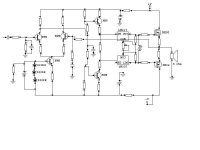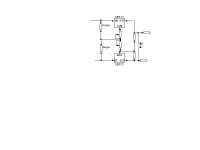In concept at least, it could work. One of the problems with three terminal regulators is that the output amp basically has 741 performance, only with a higher output current (read slow and noisy). The net result would be that you'd have to slow the amp down with a huge comp-cap, possibly to the point of where it wouldn't even do the top end of audio well. Temperature issues aside, why in the world would you want to use a clunk of a regulator like that in that kind of application??
Temperature issues aside, why in the world would you want to use a clunk of a regulator like that in that kind of application??
eeeeeeeeeh...
no reason, just a play, wanting to find new ways or maybe dead-ends
i was wondering if it is theortically possible
thanks and cheers
Why not try just one regulator and attach it's "ground"
to the Collector of the VAS current source?
to the Collector of the VAS current source?
I used a 317 to bias a MOSFET output once. It worked, but I don't remember the details. I think I was using it to hold the output of two LF351s apart by the bias voltage.
Grey
Grey
A TL431 programmable Zenner type regulator might be better, to fix the voltage between the gates of the output MOSFETS. If these were lateral types, this could be set for the zero-temp-co point, about 70mA IIRC. VMOS fets need temperature compensation, so it wouldn't be appropriate for them. Lateral MOSFETS have a lower gate threshold voltage though, so the 2,5v min for the TL431 may be too high.
The LM317 type regulators have a very high input impedence; the input voltage can change a lot, but the current through it depends only on the load resistance and output voltage. They can be used as a current source (or sink). This is why I said they will not pass the signal. Bypass caps could transfer the signal though, and the regulators do need bypass caps...
You've got me thinking
The LM317 type regulators have a very high input impedence; the input voltage can change a lot, but the current through it depends only on the load resistance and output voltage. They can be used as a current source (or sink). This is why I said they will not pass the signal. Bypass caps could transfer the signal though, and the regulators do need bypass caps...
You've got me thinking

"quote:
Temperature issues aside, why in the world would you want to use a clunk of a regulator like that in that kind of application??
eeeeeeeeeh...
no reason, just a play, wanting to find new ways or maybe dead-ends
i was wondering if it is theortically possible"
Sorry, didn't mean to come off like that. And yes, johnnyx is quite right, to actually make a functional variant you'd have to re-work the design to get both a DC and AC signal to the FETs. I was just thinking in terms of the concept of biasing with regulators, as opposed to a Vbe multiplier.
Temperature issues aside, why in the world would you want to use a clunk of a regulator like that in that kind of application??
eeeeeeeeeh...
no reason, just a play, wanting to find new ways or maybe dead-ends
i was wondering if it is theortically possible"
Sorry, didn't mean to come off like that. And yes, johnnyx is quite right, to actually make a functional variant you'd have to re-work the design to get both a DC and AC signal to the FETs. I was just thinking in terms of the concept of biasing with regulators, as opposed to a Vbe multiplier.
Floating series regulators would probably allow to set the biasing properly but the drive signal will never reach the gates of the output devices since series voltage regulators are particulary designed to not allow voltage variations applied to their inputs to propagete to their outputs [Wasn't that called voltage regulation?]
Both VAS sides would be permanently saturated
Use shunt regulation instead
Both VAS sides would be permanently saturated
Use shunt regulation instead
http://www.linear-tech.com/prod/datasheet.html?datasheet=113
Purpose deisgned bias regulator, LT1166, designed for FETs, add a diode and will run BJTs too.
Purpose deisgned bias regulator, LT1166, designed for FETs, add a diode and will run BJTs too.
All this hoopla about using a DC voltage regulator for a bias source dosn't seem to make sense. As I read in this thread the slew rate would indeed be poor, probably worse than a 741. At least a 741 has a high open loop gain. Anyway, why not just use a current source (or current mirror if the rails for the driver stage is regulated) to bias the outputs and save money and headache. This will work for sure, frequency responce shouldn't really be affected. Instead of regulating voltage, regulate current. A regulated current will have a regulated voltage accross a set impeadence like bias resistors. Ohms Law.
In changing the reference point for the DC amplifier(LM317) it can only change so fast and when compared with high freq. range audio, this DC amp will follow this reference like a slimy slug. Adding capacitors will only slow it down more. (not bi-pass caps)
You may also find that the voltage limitations may make it hard to use in a high power amp this way.
In changing the reference point for the DC amplifier(LM317) it can only change so fast and when compared with high freq. range audio, this DC amp will follow this reference like a slimy slug. Adding capacitors will only slow it down more. (not bi-pass caps)
You may also find that the voltage limitations may make it hard to use in a high power amp this way.
You don't need a slew rate for a bias control, just a constant bias generator. It can be bypased for signals with a cap.
How fast do you think the usual Vbe multiplier bias circuit tracks the temperature of the output transistors?
The LT1166 looks interesting. How available are they? Do LT give away free samples?🙂
How fast do you think the usual Vbe multiplier bias circuit tracks the temperature of the output transistors?
The LT1166 looks interesting. How available are they? Do LT give away free samples?🙂
- Status
- Not open for further replies.
- Home
- Amplifiers
- Solid State
- Integrated regulators for smart bias control


